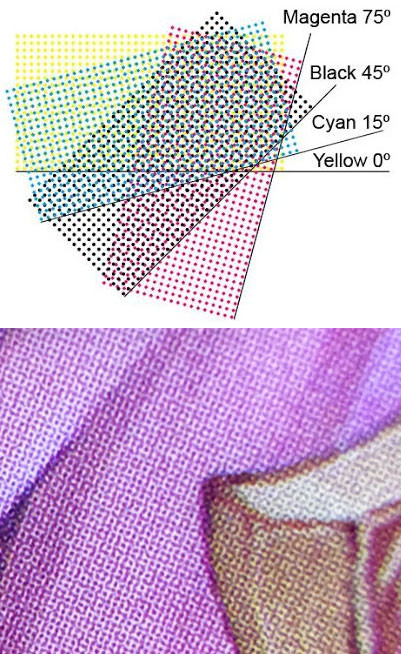What is Screen Angles
In offset printing, each ink color (cyan, magenta, yellow, black) is halftoned at a slightly different angle. This prevents the dots from stacking on top of each other in straight lines, which would create strange patterns called moiré.
Why are screen angles important?
When halftone screens are set at the right angles, the dots overlap in a way that looks natural to the eye. Instead of distracting patterns, you see smooth, blended colors.
What angles are typically used?
- Black (K): 45°
- Magenta (M): 75°
- Cyan (C): 105°
- Yellow (Y): 90°
Why are the screen angles set at 45°, 75°, 105°, and 90°?
These angles are chosen because they minimize visible patterns and create a balanced result when the CMYK dots overlap. Black is set at 45° since the human eye is most sensitive to its patterns, and this angle makes them least noticeable. Magenta and cyan are placed 30° apart (75° and 105°) to avoid interference, while yellow is set at 90° because its dots are light and less visible to the eye. This combination creates what’s called a “rosette” pattern, which blends the colors smoothly without distracting moiré.
Can screen angles change the look of my book?
Yes. Incorrect angles can create moiré patterns that look like wavy lines or ripples across an image. Correct angles ensure the image looks smooth and natural.
Do I need to worry about screen angles as a customer?
Not at all. Screen angles are part of the printer’s setup process. Your main focus should be on providing high-quality images. We handle the technical details like angles to make sure your book looks right.
When do screen angles need to be adjusted?
Screen angles rarely need adjustment, but printers may change them in special cases. This can happen if an image has fine repeating patterns that cause moiré, or if a spot color is added alongside CMYK. For most book projects, the standard angles (K 45°, M 75°, C 105°, Y 90°) work perfectly, and adjustments are only made to prevent visible interference patterns.

Showing CMYK placed on each other at different angles, and the bottom image is the actual view through a magnifier.
